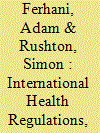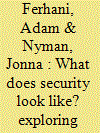|
|
|
Sort Order |
|
|
|
Items / Page
|
|
|
|
|
|
|
| Srl | Item |
| 1 |
ID:
172108


|
|
|
|
|
| Summary/Abstract |
It is often said that “diseases know no borders,” but COVID-19 has once again shown that policy responses certainly do. Governments have implemented bordering practices in a variety of ways to ensure that their own citizens are protected, even when in direct contravention to the International Health Regulations (IHR) of 2005. The IHR and the World Health Organization (WHO) have a strong preference for borders to remain open. Yet, we argue here, non-compliance by WHO member states is not the only problem with the IHR's treatment of borders. Bringing insights from critical border studies and exploring the varied ways in which the response to the COVID-19 crisis has been “bordered,” we argue that a much broader understanding of “borders” is required in the IHR and by the WHO, given that much of the exclusionary bordering we find takes place away from physical points of entry.
|
|
|
|
|
|
|
|
|
|
|
|
|
|
|
|
| 2 |
ID:
190702


|
|
|
|
|
| Summary/Abstract |
IR’s visual turn has emphasised visual analysis over visual method, centring images of war and crisis. Meanwhile security studies centres great power politics and moments of rupture. Together, they reinforce a dominant image of security as spectacular. This article unites two ethnographic projects focused on everyday security: one examining everyday security landscapes in China, and one examining health security at the UK border. Both found a gap between the dominant image of security and what we saw, and explored this gap through photography. Building on the everyday and visual turns, the article introduces interpretive photography as method to make two contributions. The first is methodological: it introduces interpretive photography as a distinct critical qualitative method that operates on five modes: enabling the seeing-capturing-making-sharing of visual artefacts, it also disrupts dominant visions and contributes to the construction of international relations. The second contribution is empirical: a deeper, richer account of what security looks like. While the discipline associates security with emergency politics or a state of exception, Nyman’s photographs show the exception-made-everyday, while Ferhani’s photos reject the exception by showing banal routines. In this way, photography engages the visuality of security, and can change how we see security.
|
|
|
|
|
|
|
|
|
|
|
|
|
|
|
|
|
|
|
|
|